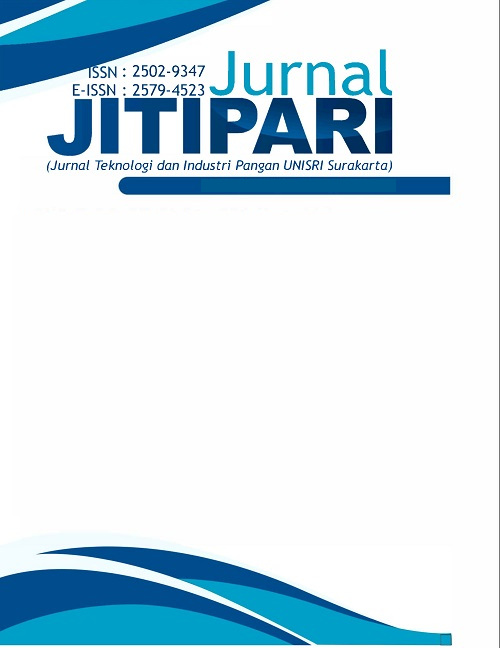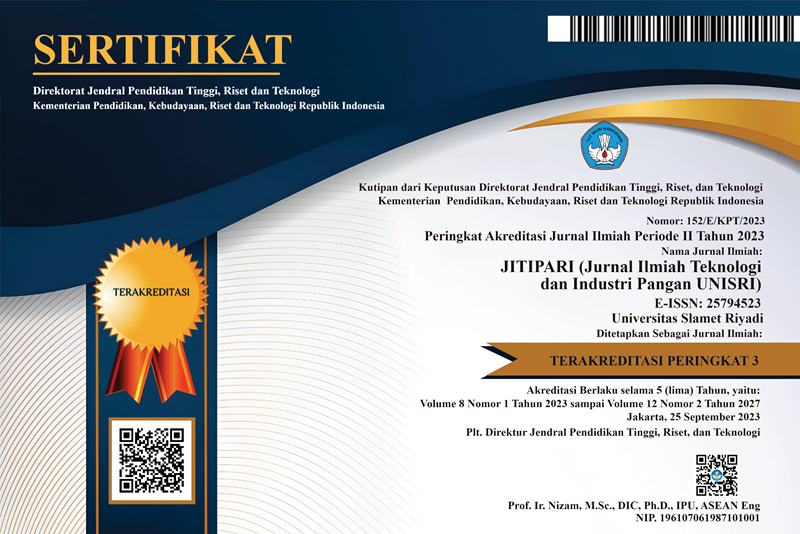Physical, Chemical and Preference Levels of Cendol Substituted with Purple Yam Flour (Dioscorea alata L.)
DOI:
https://doi.org/10.33061/jitipari.v8i2.8161Abstract
Purple yam (Dioscorea alata L.) is a local food with many sources of antioxidants, so it becomes a staple food for the community. The addition of purple yam flour to the production of cendol is expected to help increase the selling value of cendol and also purple yam. This research aims to produce cendol with the addition of purple yam flour which has antioxidant activity and liked by the panelists. A completely randomized factorial design was used in this study using 2 factors, namely the treatment of variations in the length of cooking time and variations in the concentration of purple yam flour added, so that 9 treatment combinations were obtained, namely the addition of 10%, 20% and 30% purple yam flour with a cooking time of 10, 15 and 20 minutes. The results showed that there was an effect of cooking time and the addition of purple yam flour concentration had an effect on the chemical properties and preferences of cendol.The best cendol formulation was the addition of 30% purple yam flour and 20 minutes of cooking time. The selected purple yam cendol has nutritional value: ash content 0.082%, antioxidant content 15.55% RSA, phenol content 8.33 mg GAE/g db body and anthocyanin content 15.86 mg/100 g db. Cendol substituted for purple yam flour can ward off free radicals because it has a purple pigment derived from anthocyanin, an antioxidant.
References
AOAC. (2005). Official Methods of Analysis of The Association of Analytical Chemist. Virginia USA:Association of Official Analytical Chemist, Inc.
Apriliyanti, T. (2010). Kajian Sifat Fisikokimia dan Sensori Tepung Ubi Jalar Ungu (Ipomoea batatas Blackie) dengan Variasi Proses Pengeringan. Skripsi S1. Fakultas Pertanian Universitas Sebelas Maret, Surakarta
Baah, F.D., Maziya-Dixon, B., Asiedu, R., Oduro, I., Ellis, W.O. (2009). Nutritional and biochemical composition of d. alata (Dioscorea spp) tubers. Journal of Food Agriculture and Environment. 7(2):373-378.
Basuki, N., Harijono, Kuswanto, & Damanhuri. (2005). Studi pewarisan antosianin pada ubi jalar. Jurnal Agravita 27(1): 63 – 68.
Camelia. (2021). Sifat kimia dan kesukaan cookies yang disubstitusi dengan tepung uwi ungu (Dioscorea alata L.). Naskah Publikasi Prodi THP. UMBY.
Ezeocha, V.C dan Ojimelukwe P.C. (2012). The impact of cooking on the proximate composition and antinutritional factors of water yam (Dioscorea alata). Journal of Stored Products and Postharvest Research 3(13):172–176.
Fang, Z., Wu, D., Yu, D., Ye, X., Liu, D., Chen, J. (2011). Phenolic compounds in chinese purple yam and changes during vacuum frying. Food Chemistry 128 (4):943–948.
Fang, F., Zhang, X., Luo, H., Zhou, J. Gong, Y., Li, W., Shi, Z. He, Q., Wu, Q., Li, L., Jiang, L., Cai, Z., Shamir, M., Zhang, Z., and Pang, X. (2015). An intracellular laccase is responsible for epicatechin- mediated anthocyanin degradation in litchi fruit pericap. Journal of Plant Physiology 169 (4): 2391-2408.
Fitriani, S. 2008. Pengaruh Suhu dan Lama Pengeringan Terhadap Beberapa Mutu anisan Belimbing Wuluh (Averrhoabellimbi L.). Jurnal Sagu 7(1): 32-37.
Giusti M.M, Wrolstad R.E. (2001). Unit F1.2: Anthocyanins. Characterization and Measurement with UV - Visible Spectroscopy. In: Wrolstad, RE, editor. Current Protocols in Food Analytical Chemistry. New York: John Wiley & Sons.
Hapsari, R.T. (2014). Prospek Uwi sebagai Pangan Fungsional dan Bahan Diversifikasi Pangan. Buletin Palawija 27:2 6-38.
Harris, R. S. dan E. Karmas. (1989). Evaluasi Gizi pada Pengolahan Bahan Pangan. ITB – Press, Bandung.
Kartika, B. (1988). Pedoman Uji Inderawi Bahan Pangan. Pusat Antar Universitas Pangan dan Gizi. Yogyakarta: Gadjah Mada University Press.
Lachman, L., H. A. Lieberman., J. L. Kanig., (2009). Teori dan Praktek Farmasi Industri. 3rd Edition. Penerjemah: Siti Suyatmi. Jakarta : UI Press. 101- 246 hal.
Marszalek, K., Wozniak, L., Kruszewski, B., & Skapska, S. (2017). The effect of high pressure techniques on the stability of anthocyanins in fruit and vegetables. International Journal of Molecular Sciences 18: 1 – 23.
Murni, M. 2014. Pengaruh Penambahan Tepung Tempe Terhadap Kualitas dan Citarasa Naget Ayam. Berita Litbang Industri 3(2): 117-123.
Nina, K.C.J., Ghislaine, D.C., Hubert, K.K., Desire Patrice, A.Y., Patrice, K.L., Alphonse, K. (2017). Biochemical and functional properties of yam flour during the post-harvest conservation of dioscorea alata cultivar azaguié. Journal of Applied Science and Technology 21(6):1–10.
Nintami, A.L., Rustanti, N. (2012). Kadar serat, aktivitas antioksidan, amilosa dan uji kesukaan mi basah dengan substitusi tepung ubi jalar ungu (Ipomea batatas var Ayamurasaki) bagi penderita diabetes melitus tipe-2. Journal of Nutrition College 1(1): 382–387.
Pujimulyani, D., Raharjo, S., Marsono, Y., dan Santoso, U. (2010). Aktivitas antioksidan dan kadar senyawa fenolik pada kunir putih (Curcuma mangga Val.) segar dan setelah blanching. Jurnal Agritech 30(2): 68-74.
Rulani, Melati. (2022). Pengaruh substitusi tepung terigu dengan tepung uwi ungu terhadap karakteristik fisikokimia dan organoleptik kue stik bawang. S1 thesis. Universitas Jambi.
Salma, Rasdiansyah, dan M. Muzaifa. (2018). Pengaruh penambahan tepung ubi jalar ungu dan karagenan terhadap kualitas mi basah ubi jalar ungu (Ipomoea batatas cv. Ayamurasaki). Jurnal Ilmiah Mahasiswa Pertanian. 3(1): 357-366.
Shivaprassad, H.N., Mohan, S., Kharya, M.D., (2005). In-Vitro Model For Antioxidant Activity Evaluation. a review. http://www.pharmainfo.net.
Siahaan, L.O., Hutapea, E.R.F., Tambun, R. (2014). Ekstraksi pigmen antosianin dari kulit rambutan (Nephelium lappaceum) dengan pelarut etanol. Jurnal Teknik Kimia USU 3(3) : 32- 38.
Suhartatik, Nanik W., Y. Asrie. (2009). Aktivitas antioksidan teh rambut jagung (Zea Mays L. sacharata) dengan penambahan rosela (Hibiscus sabdariffa L.) dan variasi lama pengeringan. Jurnal Teknologi dan Industri Pangan. 3(2): 113-120.
Suyantoro, Sigit. (2014). Mengolah Data Statistik Hasil Penelitian Menggunakan SPSS. Semarang: CV. Andi Offset
Tamaroh, S., Raharjo, S. (2017). Pengaruh perlakuan blanching pada total antosianin, total fenolik dan aktivitas antioksidan pada pembuatan tepung uwi ungu (Dioscorea alata L.). Seminar Nasional Perhimpunan Ahli Teknologi Pangan Indonesia (PATPI). Hlm. 446-452.
Tamaroh, S., Raharjo, S., Murdiati, A., Anggrahini, S. (2018). Perubahan antosianin dan aktivitas antioksidan tepung uwi ungu selama penyimpanan. Jurnal Aplikasi Teknologi Pangan 7(1): 31-35.
Winarti, S dan Erwan A.S. (2013). Karakteristik tepung prebiotik umbi uwi (Dioscorea spp). Jurnal Teknik Kimia. Vol 8(1): 17-21.
Winarno, F.G. (2002). Kimia Pangan dan Gizi. Jakarta: Gramedia Pustaka Utama.
Winarno, F.G. (2009). Kimia Pangan dan Gizi. Jakarta: Gramedia Pustaka Utama.
Xu, B.J., Chang, S.K.C. (2007). A comparative study on phenolic profiles and antioxidant activities of legumes affected by extraction solvent. Journal of Food Science. 72 (2): 59-66.
Yudiono, K. (2011). Ekstraksi antosianin dari ubi jalar ungu (Ipomoea Batatas Cv. Ayamurasaki) dengan teknik ekstraksi subcritical water. Jurnal Teknologi Pangan 2(1): 1–30.
Yudhistira, A. (2018). Kualitas Mie Kering dengan Substitusi Tepung Uwi Ungu (Dioscorea alata). S1 thesis. UAJY.
Downloads
Published
How to Cite
Issue
Section
License
Copyright (c) 2023 Siti Tamaroh

This work is licensed under a Creative Commons Attribution-ShareAlike 4.0 International License.
Authors who publish this journal agree to the following terms:
- Authors retain copyright and grant the journal right of first publication with the work simultaneously licensed under a Creative Commons Attribution-ShareAlike 4.0 International (CC BY-SA 4.0) that allows others to share the work with an acknowledgement of the work's authorship and initial publication in this journal.
- Authors can separately make additional contractual arrangements for non-exclusive distribution published by the journal (e.g., publish it in a book), with an acknowledgement of its initial publication in this journal.
- Authors are allowed and encouraged to send their work via online (e.g., in the institutional repositories or their website) after published by the journal.










